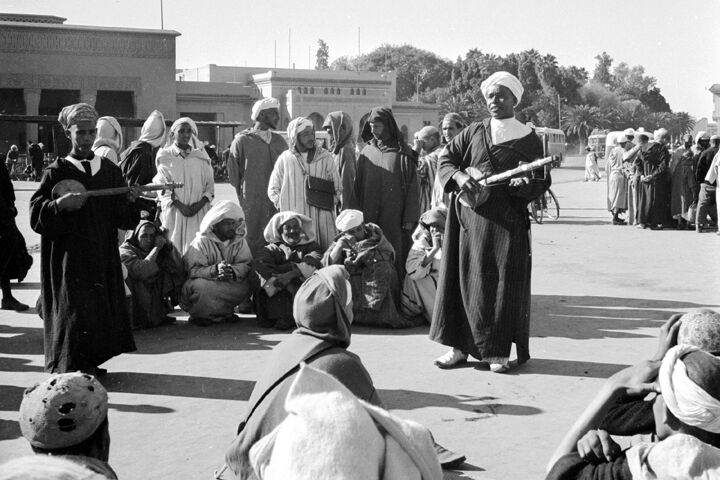
Herbert W. Armstrong Served Morocco’s Social Welfare
“I’m in flight, just out of Bangor, Maine, where we cleared immigration and customs. We had a very successful trip to Morocco,” wrote Herbert W. Armstrong to co-workers June 8, 1979. It was his first trip to this North African country that has been home to the Berbers since the second millennium.
This unique and diverse land is situated on the Mediterranean across from the Strait of Gibraltar and also features an Atlantic coastline.
The country’s southern border is with Mauritania, while Algeria is to the east. Fertile land toward the coast and the 11,000 foot Atlas mountain range compliment this strategically located land fought for by European nations in their pursuit of past imperial ambitions.
Morocco’s King Hassan ii of the Alawite dynasty, which has ruled since 1660, appointed Maati Bouabid as prime minister in March 1979. He would lead the country through November 1983.
“We met and picked up some of my ‘Japanese sons’—members of the Japanese Diet—at Paris, had a visit with the prime minister at Rabat, Morocco,” wrote Mr. Armstrong (ibid).
Back in California, the local press reported on the trip, writing that Mr. Armstrong “presented them with the customary gifts, and laid the groundwork for humanitarian projects as he has in many other nations” (Pasadena Star News, June 24, 1979).
It was Mr. Armstrong’s regular practice to visit the Steuben crystal factory and personally select items for presentation to many of the leaders he met, such as Prime Minister Bouabid.
The trip to Morocco came just months after the landmark unlawful attack by the state of California in 1979 against the Worldwide Church of God. This was exacerbated by renowned 60 Minutes journalist Mike Wallace’s unsubstantiated taunting of Herbert W. Armstrong concerning the attorney general’s false allegations of misappropriation of funds, citing as an example of extravagance the gifting of Steuben crystal.
Addressing such unfounded allegations, Mr. Armstrong wrote co-workers on January 28, 1979, “They have tried to treat as ‘extravagance’ such things as the purchase of Steuben crystal—which is about the only type of art object made in this country fitting for presenting to a king, president, or prime minister. Look into your Bible, Matthew 2:11, and see that the wise men presented gifts to Christ as an infant. This was not a birthday present, for it was many days after His birth. But since long before Christ it has been custom to present a gift when visiting a king or head of government.”
“And certainly the good citizens of Pasadena would like to know when leaders of institutions headquartered in the area are received and honored by heads of government abroad,” wrote the same Pasadena Star News piece, “and about significant humanitarian projects being planned by Pasadena institutions.”
The meetings with the prime minister of Morocco centered upon problems in the field of social welfare and also recounted the work of Mr. Armstrong and the humanitarian adjunct of his work, Ambassador International Cultural Foundation (aicf).
Four years earlier, on June 5, 1975, as its founder Mr. Armstrong announced, “Some weeks ago I authorized the formation of a new foundation—named the Ambassador International Cultural Foundation. It is non-profit, dedicated to serving humanity worldwide. It has become a necessary adjunct to this new worldwide dimension of getting Christ’s true gospel to the nations through heads of government.”
In addition to Mr. Armstrong’s goodwill visits with world leaders, aicf supported “activities ranging from benefits for handicapped children to major cultural events; from agricultural research to hospitals; from archaeological excavations to parks for children” (Plain Truth, February 1979). These broad horizons of humanitarianism included the use of Ambassador Auditorium in Pasadena, California, to host cultural programs, international exhibitions, nationally televised music specials and archaeological exhibits.
The subject of social welfare that was discussed in Rabat is generally defined as helping people in need. However, the aicf was not an activity rewarding national slothfulness. Africa’s leaders were “impressed by these concrete evidences of humanitarian concern for others and a definite manifestation of a willingness to help others to help themselves” (Bulletin, June 3, 1975).
That was the mission in Morocco: “a definite manifestation of a willingness to help others to help themselves.”
After the visit to Rabat, the Moroccan ambassador attended what Mr. Armstrong recalled as “a large banquet in my honor at Tunis, at a resort hotel on the Mediterranean shore.”
The trip had a profound impact upon the ambassador for world peace, with one of his aides reflecting that “he was in good spirits and had many plans for the future.”
Following his death in 1986, those appointed to perpetuate the work of the foundation scrapped and closed its service of godly social welfare.
It would not be until 1996 that a revived, reborn and refreshed foundation—Armstrong International Cultural Foundation—once again set about to serve mankind through cooperative international endeavors.
Armstrong International Cultural Foundation founder and chairman Gerald Flurry’s dedicated efforts across the past two decades involving various countries and cultures are proof that he is honoring the request of emperors, kings, queens, princes, presidents and prime ministers, along with a myriad of dignitaries from around the globe, from places like Morocco, who met and worked with Herbert Armstrong and the foundation during his life, to perpetuate that legacy.
Through these efforts, the foundation continues its contribution toward bringing about understanding between all peoples in the march forward to soon-coming world peace.
